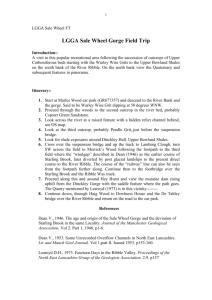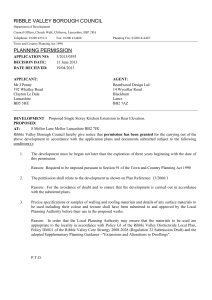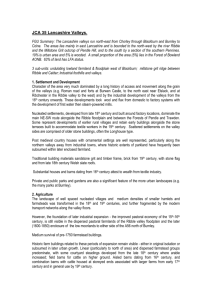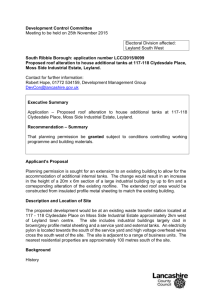River Ribble - Mersey Basin Campaign
advertisement
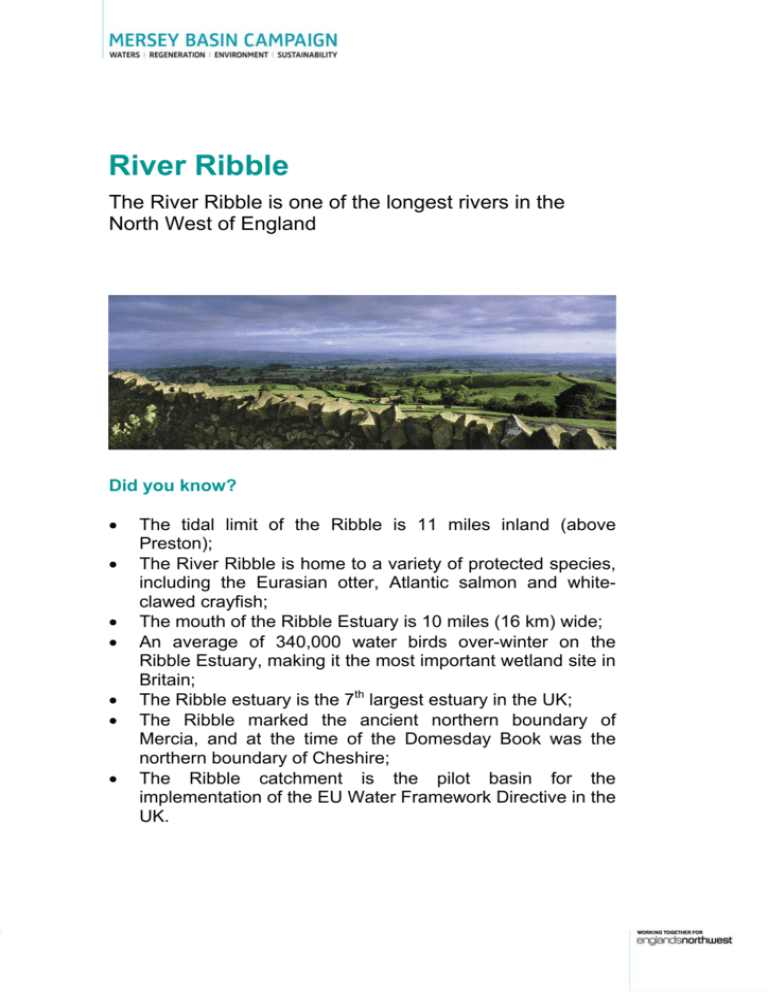
River Ribble The River Ribble is one of the longest rivers in the North West of England Did you know? • • • • • • • The tidal limit of the Ribble is 11 miles inland (above Preston); The River Ribble is home to a variety of protected species, including the Eurasian otter, Atlantic salmon and whiteclawed crayfish; The mouth of the Ribble Estuary is 10 miles (16 km) wide; An average of 340,000 water birds over-winter on the Ribble Estuary, making it the most important wetland site in Britain; The Ribble estuary is the 7th largest estuary in the UK; The Ribble marked the ancient northern boundary of Mercia, and at the time of the Domesday Book was the northern boundary of Cheshire; The Ribble catchment is the pilot basin for the implementation of the EU Water Framework Directive in the UK. Location and Basic Geography Map showing the catchment of the River Ribble in North West England. Location and Basic Geography The Ribble Basin, located in the North West of England, includes all of the land that drains into the Ribble Estuary. This includes five main rivers and all their tributaries (the Ribble, Hodder, Calder, Darwen, and Douglas) and the Crossens drainage system. The River Ribble rises in the Pennines in the Yorkshire Dales at the confluence of Gayle Beck and Cam Beck. It flows east 100km before running into the Irish Sea. It is one of the longest rivers in the North West, draining a catchment of 2128 km2 (860 miles2) and covering a distance of 110 km from source to sea. The catchment has a population of 1.25 million, concentrated in a few urban areas including Preston, Blackburn, Wigan, and Blackpool, with the rest of the catchment (90%) predominantly rural. Agricultural activity is extensive throughout the Ribble area. The uplands above Settle and the Trough of Bowland are largely sheep farming areas with dairy predominating on the lower river. In the upland catchment, the farming is based around small villages. This area attracts tourists and is popular for recreation, such as a walking and fishing supported by the high water quality. However, some upland farms are located on permeable limestone so spillages and other releases of pollutants can enter groundwater quickly, and re-emerge in surface waters deteriorating water quality. The problem is compounded by the soil of the Ribble area being predominantly clay, which increases the diffuse pollution from agricultural run-off. The mid Ribble is joined south of Clitheroe by two major tributaries: the Hodder and the Calder. The River Hodder rises in the Forest of Bowland where it is dammed near to its source to form Stocks Reservoir, which provides a large proportion of drinking water for the Blackburn area. This 25-mile river is mainly upland in characteristics, surrounded by sheep-grazed fells. Otters have been spotted on the Hodder indicating high water quality, along with the presence of salmonid fish species, such as Atlantic salmon. The River Calder, crossing East Lancashire, contrasts to the Hodder in that it is a post-industrialised river, exhibiting pollution from relics of mining, contaminated land run-off and sewage discharges. Retaining walls, weirs and culverts constrain parts of the river as it flows through the industrial towns of Burnley, Nelson and Colne where the river was used to power the regions cotton mills and their accompanying bleaching and dyeing works. The River Darwen joins the Ribble on Preston’s urban fringe. The upper Darwen starts as a moorland stream before it and its tributaries are culverted as they flow through the towns of Darwen and Blackburn. The Darwen provided power to the cotton and woollen mills of Blackburn and Darwen in the 18th and 19th Centuries. These have left a legacy of many weirs throughout this river system, which create a barrier to movement for migratory fish such as salmon. As it flows from these urban centres, the Darwen river corridor is dominated by narrow valleys, open fields and woodland before it joins the Ribble near Preston. From Preston, the Ribble was diverted from its natural course to allow the development of Preston Dock, with the straight channel carrying the river out to the estuary. In 1840, the river was trained by the construction of a low rubble wall, straightening and deepening the river allowing navigation to Preston Docks. The surrounding marshes and salt marsh areas have been extensively drained and fertilised, and by mid 16th Century much of the marshland had been converted to agricultural land. The Douglas and Crossens both rise at relatively low altitude, draining extensive areas of flat land where intensive agriculture and horticulture dominate before flowing into the Ribble Estuary. The Crossens drainage system lies less than 4 metres above sea level, and a lot of the area is below the high-tide mark. The watercourses are pumped and heavily modified to improve flood defences and land drainage. The mossland in the Crossens drainage system is an important conservation area, especially for migratory birds at Martin Mere. The Douglas rises on Rivington Moor, before travelling 23 miles to meet the River Ribble. In the 19th Century, the River Douglas was an important navigable river and part of the tidal section is still used as an extension to the Leeds-Liverpool Canal. The Estuary is internationally recognised for its biodiversity. The wildlife habitat of the Ribble Estuary is protected by a series of Nature Reserves, sites of special scientific interest (SSSIs) and international conservation designations; half of the Estuary is designated as a Ramsar site, a designation for internationally important wetlands. Low tides in the estuary reveal extensive mud and sand flats, supporting tens of thousands of migratory birds for which the Ramsar designation has been awarded. The Ribble Estuary supports the highest UK populations of wigeon, sanderling and ringed plover. Water Quality of the River Ribble The Ribble Basin covers a varied landscape that has been shaped by a variety of activities, including livestock farming in the upper catchment to the industrialised urban areas such as Blackburn in the middle catchment. These activities have all had an impact upon the water quality and quantity of the Ribble. Historically, the landscape has also been modified as watercourses and wetlands were altered to improve land drainage. The general pressures on land and water include: • The development and growth of urban areas; • Transport networks criss-crossing the catchment; • Changing agricultural markets and the intensification of agriculture, especially in the context of diffuse water pollution; • The use of land by extractive industries across the river basin from limestone in the head-waters to sand extraction in the estuary; • Water abstraction in parts of the catchment, leading to low flow problems. The Future The EU Water Framework Directive aims to bring the Ribble, and all other surface waters in Europe up to ‘good ecological status’. Currently, the Ribble catchment is being used as the national pilot for implementing the Directive. See the fact sheet on the Water Framework Directive for further information. Further Information See the Local Action Partnership web pages in this site, for information relating to local information on the Ribble and its tributaries. See the Environment Agency web pages for further information on the River Ribble: http://www.environmentagency.gov.uk/regions/northwest/346910/347005/440418/441073/?version=1&la ng=_e Information on the Millenium Ribble Link; the first new navigation to be built since the Manchester Ship Canal in the 19th Century. http://www.millenniumribblelink.co.uk/skipguide.htm
